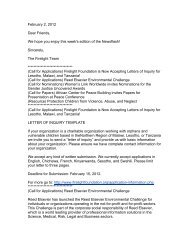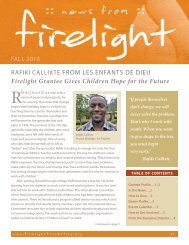From Faith to Action - Faith to Action Initiative
From Faith to Action - Faith to Action Initiative
From Faith to Action - Faith to Action Initiative
- No tags were found...
You also want an ePaper? Increase the reach of your titles
YUMPU automatically turns print PDFs into web optimized ePapers that Google loves.
Grassroots Solutions Help Communities Address Their Own NeedsGrassroots efforts <strong>to</strong> support children and families mobilize local resources, inspirecommunity ownership, and build community strength in a variety of ways. Mostcommunity and faith-based organizations have lean budgets and minimal, if any,paid staff. Motivated by compassion, goodwill, and seeing children in need of help,volunteers — often neighbors and members of the community themselves — arethe backbone of many grassroots efforts. Many volunteers are also poor, and it isimportant <strong>to</strong> ensure that they receive training opportunities, recognition, and othertypes of support.“ Community members are taking up the challenge by sustaining life andgiving love — providing home-based care and visitation. Moreover, they areproviding hours of their time without compensation and donating their ownscarce resources…as good neighbors and caring people, they have responded<strong>to</strong> the inhumane gap in access <strong>to</strong> care and support in poor communities.”~Esther Mwaura Muiru, GROOTS, KenyaMany Different Organizations Support Children and FamiliesGrassroots responses vary greatly in their size and in the scope and scale of theirservices. In their simplest form, community organizations are small informalgroups that have come <strong>to</strong>gether <strong>to</strong> address a local need. Among them are the manythousands of faith-based groups and congregations that are providing assistance<strong>to</strong> vulnerable children in their communities. As groups expand, they may hire staffand seek outside funding. Local faith-based groups may receive support throughtheir religious networks at the district, national, and international levels. In addition,a growing number of larger non-governmental organizations work closely withcommunities <strong>to</strong> encourage and support local efforts. Collectively, this diverse groupof organizations is working at the ground level <strong>to</strong> ensure that hundreds of thousandsof children receive support and remain in family care.Local Programs Grow in Response <strong>to</strong> Real NeedsExamining how different community and faith-based groups identify prioritiesdemonstrates that there is no single right way <strong>to</strong> do things. Problems are bestaddressed when the people most directly involved in a situation develop their ownsolutions, while also being able <strong>to</strong> draw on successful practices gleaned from otherresources. The approaches and activities used vary as each group determines theform of assistance that best meets the needs of its population. Many groups start byproviding one type of assistance, and then add on services as they see the need.A Variety of Activities Offer the Best ResultsGrassroots and faith-based groups provide different programs and activities <strong>to</strong>strengthen family and community care for orphans and vulnerable children. Whileeach individual group may serve a relatively small population, the collective forceof these local initiatives is tremendous. The following pages highlight a rangeof strategies that have been shown <strong>to</strong> be effective. S<strong>to</strong>ries and examples fromorganizations that are making a difference in the lives of children provide anillustration of these strategies in action.<strong>Faith</strong>-Based OrganizationsIt is impossible <strong>to</strong> overemphasize theimportance of faith throughout Africa,where some two million churches,mosques, and other religious groupsblanket the continent. The term“faith-based organization” (FBO)is used <strong>to</strong> describe groups withreligious affi liations or established bycommunities of faith. They includecongregations, their coordinatingbodies, mission hospitals andschools, and faith-driven nongovernmentaland community-basedorganizations. FBOs offer some of themost extensive, best organized, andmost viable networks of communityorganizations throughout Africa.They play a signifi cant — thoughoften under-recognized — role inresponding <strong>to</strong> the health, education,and social welfare needs of childrenand families.Kisumu Urban Apos<strong>to</strong>lateProgramme–Pandipieri,Kisumu, KenyaStarted by missionary Hans Burgman andcommunity members <strong>to</strong> serve the shantyareas of Kisumu, Pandipieri began as ahealth program for the poor and lateradded an education program for streetchildren. As the impact of HIV/AIDSspread, Pandipieri responded by expandingits programs. Serving a community witha 27% HIV prevalence rate, Pandipierinow offers over 20 different programsreaching thousands of adults and children,including education support, vocationaltraining for youth, a health center and amobile clinic, home-based care services,income-generating activities, andpsychosocial services and pas<strong>to</strong>ral care.While exceptional in its scale and scope,Pandipieri’s progression from a smallorganization offering a single program <strong>to</strong>a more comprehensive service providerfollows a course that is shared by othercommunity organizations that havereceived outside support <strong>to</strong> help them grow.5








